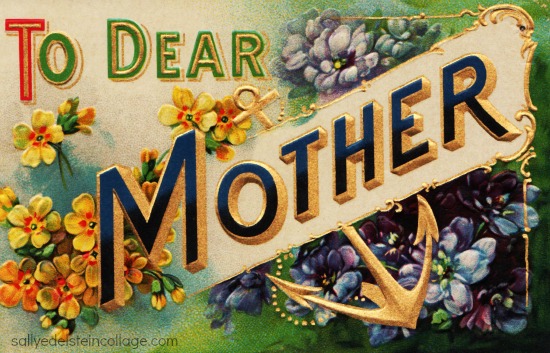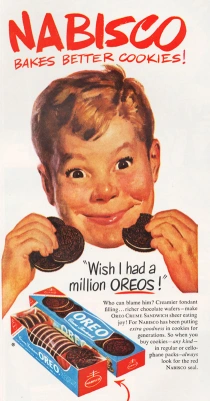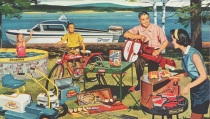In 1926 while flaming youth roared and thousands mourned the death of Rudolph Valentino, my grandparents, Sadie and Arthur were overjoyed at the birth of their second daughter, Betty, my mother.
A beloved Bastille Day baby, this jazz age babe would have turned 90 today.
Smack dab in the middle of the roaring twenties, eight years had passed since the end of the Great war and Americans were ready for fun. Our president, Silent Cal was keeping mum as the economy skyrocketed. Consuming goods as never before, folks were running down to Florida in get-rich-quick schemes, while Miss Texas Guineas, the boop-boop-de-doop speakeasy girl beckoned us “to live it up.”
There was no better time to be born.
Betty would be the beneficiary of modern science and technology providing a safer and cleaner world than the previous generation. Worries about childhood dangers that had kept previous mothers up at night were soon banished.

“A summer time baby used to cause concern. Watch baby’s health in summer! Down through the ages grandmothers passed this warning on to mothers. For with summer came ‘the critical period’ a time when even a symptom of illness brought grave anxiety. For years mothers faced warm weather with dread. The dangers that confronted their children were mysterious dangers. They knew not what to guard against. But how different it is today! There is nothing mysterious now about the risks that come with summer. Its simply foods spoil more quickly and bacteria develop more rapidly. And to meet these risks authorities everywhere prescribe better refrigeration…and you can provide this better refrigeration with Frigidaire the automatic refrigerator to keep foods at low temperatures Keeping foods safe and wholesome.” Vintage ad 1926 Frigidaire
Thanks to the benefits of new automatic refrigeration to keep baby’s food fresh, antiseptic sanitary homes free of germs, the use of cod liver oil that had all but eliminated childhood rickets and the well documented health giving benefits of direct sun light to help baby thrive, “Today’s child will have better health than yesterday’s,” was the conventional wisdom.
Summer born baby Betty could benefit from a good sun bath full of ultra violet rays right away.
“Today’s child,” we learned in a 1926 article in Woman Home Companion, “is born into a world somewhat more elaborate and complex than one upon yesterdays child opened his eyes. In the past 5 years the greatest growth has been in pediatrics- better health for baby, better education for mothers”
The Modern Mother Expects
By 1926 my grandmother Sadie was already experienced at this pregnancy business. My second time grandmother had first hand knowledge on pregnancy-what to expect when you’re expecting. Sadie epitomized the modern young mother defined in Ladies Home Journal as “a woman who seems to have the capacity for pleasure of the post war girl and the conscientiousness of a scientist.”
In the year Mom was born, women had had the vote for only six years and emancipated women were ready to cut loose. Sporting a stylish bob, always impeccably dressed in her modish Lane Bryant flapper apparel especially for mothers-to-be, Sadie was considered a regular “gal on the go,” compared to a pregnant woman in her own mothers generation who were “indisposed” throughout the full nine months.
Baby Bound In the Jazz Age

The containment policy was in full effect when it came to pregnant women in the 1920’s. Limited activity and a good maternity girdle were the rule. Vintage Maternity Wear Corsets 1926 Sears Roebuck
Emancipated or not, a baby-bound lady still had to sit around like a mother hen, patiently waiting so as not to tire herself out. There were strict rules concerning a woman in the family way as advised by the medical community. The expectant mother in the 1920’s was gently advised “to lead a quiet, cheerful life and avoid mental as well as physical upheavals, crowds, poorly ventilated or overheated places. And limit yourself to leisurely walks to soak in the well known benefits of the sun…”
Best to stick to AMA approved activities like reading cheerful books, knitting or chatting, but, heaven-forbid-nothing too controversial please!
Mothers-to-be stilled believed in pre-natal impressions.
These so-called maternal impressions implied that a child in the womb would be marked in some obscure and possibly ominous way by what the mother thinks, feels or sees during pregnancy especially if the experience is shocking or disagreeable. The mother to-be had to “avoid all shocking, painful or unbeautiful things” intellectual stimulation, angry or lustful thoughts” or risk the baby be deformed or stunted in the womb.
My grandmother was always convinced that the small birthmark on her own cheek was the result of a very un-frightening leaf falling on her mothers belly while pregnant with her, so was cautious while pregnant with Betty.
But modern motherhood was being helped along by scientists who firmly planted themselves into mamas life to help them become their own experts.
Mother Knows Best
It was at the beginning of the last century, that inexperienced mothers were told, that modern motherhood required discipline, control and most important scientific expertise. Modern mothers, Sadie had gently pointed out to her sweet-but-naive mother, unlike old-fashioned ones, had to be educated on being a mother.
When my very proper, and very pregnant, Great Grandmother Rebecka arrived from London at Castle Gardens, New York in 1888, she was met by some representatives of the N.Y. Bureau of Hygiene.
Unsolicited, these gentlemen handed her a popular government issued pamphlet entitled “Mutter und Kind” which provided practical, scientific information on pregnancy, childbirth, infant care, hygiene, proper diet and over all advice on American child rearing ideas…all conveniently printed in Yiddish.
Besides being mortified at the unexpected and unwelcome intrusion in to what was considered a private affair, my Great Grandmother dismissed it as a lot of mishegoss. “Schedules, schmedules.. .a baby eats when he’s hungry! I should worry that I won’t have a good chubby baby,” she would indignantly recall years later.
The booklet she was given, for example, had stressed that fat babies were healthy babies. As if she needed some nudnik from the government to tell her that. Thinness was associated with diseases, like God-forbid-Consumption. Rebekah didn’t need some big shot American doctor telling her that a good supply of fat would help her children survive illness.
“Maybe for some lazy-you-should-excuse-the-expression-modern-woman, learning about muttershaft (Yiddish for mothercraft) from some meshggeneh Yiddish pamphlets written by who-knows-who-why-should-I-trust-these-so-called-mavens-that-I-don’t-know-from-a-hole-in-the-wall, was okay,” she would gripe, but not for this yiddisher mama.
Common sense was all she needed.
Who Do You Trust
Just as years later my mother Betty would disregard her own mother’s out-of-date-ways, Rebekah’s daughter Sadie, knew one thing for sure, when she became a mother. Common sense was old-fashioned.
Being an up-to-date Post World War I mother, Sadie would rely on the wisdom and authority of doctors and experts and there were no shortages of them willing to give their two cents. The advice her mother Rebekah had so flippantly ignored, was by the 1920’s, gospel.
A new age of child care had indeed dawned and by 1926, lucky little Betty along with all the greatest generation would be the recipient of all the newest knowledge, much of it gleaned from sanitary laboratory studies.

Lucky little Betty along with all the greatest generation would be the recipient of all the newest knowledge.
These would be wonderful times in which to be a baby, the experts assured mothers.
Plenty of sunshine and fresh air-scientific feedings-strictly scheduled sleeping…so much to help the little lives thrive. Out of this petrie dish of discovery would evolve a wholesome, organized, disciplined child. My Great Grandmas’ sloppy, cuddly, catch-as-catch-can ways were summarily dismissed as irresponsible.
Sadie knew she had only to pick up a copy of McCall’s magazine to confirm what she knew- that motherhood was indeed a scientific endeavor results. And that was true whether you were raising cattle, hogs, dogs or children. Each baby had to pass rigid standards for health, size and fast growth, if you wanted better than average babies.
Of all the child care experts, the big Daddy of them all was behaviorist Dr. John Watson, the swami of scheduling and self-control whose column appeared regularly in McCall’s in the 1920’s and 30’s.
When Sadie was a newborn, babies were always fed when they were hungry. A baby cried, he got fed. After WWI, pediatricians were aghast at earlier haphazard ways and established rigid, industrial, on the clock feeding. As soon as baby was born he was punching a time clock.
Instincts were now out…science was in. Housewives no longer trusted their good sense or the wisdom of countless generations of mothers but came to rely on the experts’ knowledge.
© Sally Edelstein and Envisioning The American Dream, 2016. Unauthorized use and/or duplication of this material without express and written permission from this blog’s author and/or owner is strictly prohibited. Excerpts and links may be used, provided that full and clear credit is given to Sally Edelstein and Envisioning The American Dream with appropriate and specific direction to the original content.




















Love this…
Instincts were now out…science was in. Housewives no longer trusted their good sense or the wisdom of countless generations of mothers but came to rely on the experts’ knowledge.
LikeLike
My parents took pictures similar in 1949!
LikeLiked by 1 person
That’s great! Curiously enough, you couldn’t post these pictures on facebook today they have very strict rules about children and “nudity.”
LikeLike
Got two more Sally…
https://sadp.wordpress.com/2009/12/31/fin-decembre-1948-2-h-10/
LikeLike
Make that early 1950. I just asked my wife… A mother should know how to date pictures of babies. I would say summer of 1950 in my paternal grandparents’ place.
LikeLike
Classically adorable, dry evocative of the times.
LikeLike
Reblogged this on Our Ancestors and commented:
Interesting post with lovely baby pictures
LikeLike
Thanks for the reblogg
LikeLike
Getting these in my inbox just makes my day! From the vintage images to the modern-day lessons, your blog does more to make me smile, cringe, and contemplate than any other. Thank you!
LikeLiked by 1 person
Well Rachel, your comment just made my day! Your response is exactly the sort of emotions I hope to elicit.
LikeLike
I feel the very same way. I have hooked several of my friends and family on Sally’s wonderful blog. Thank you Sally!
LikeLiked by 1 person
Thank you Laura and thanks for sharing my blog with others. It is my great pleasure creating this and knowing others enjoy it.
LikeLike
Great post. Amazing how the human race made till all the modern science stepped in to give mothers advice. I’m not sure where my mother got her information. All I know is that she believed that castor oil and vicks vapor rub could cure anything. The way she applied it, I had to be very sick before I would let on that I was sick. Just a thought. I’ve wondered for years if Mr. Spock on Star Trek was named after Dr. Spock. Could it be that his job on Star Trek was to burp Captain KIrk from time to time.
LikeLiked by 1 person
Oh memories of vics vapo rub…the glue that binds baby boomers! I can still smell and feel that goop on my chest. Good theory about Dr Spock
LikeLiked by 1 person